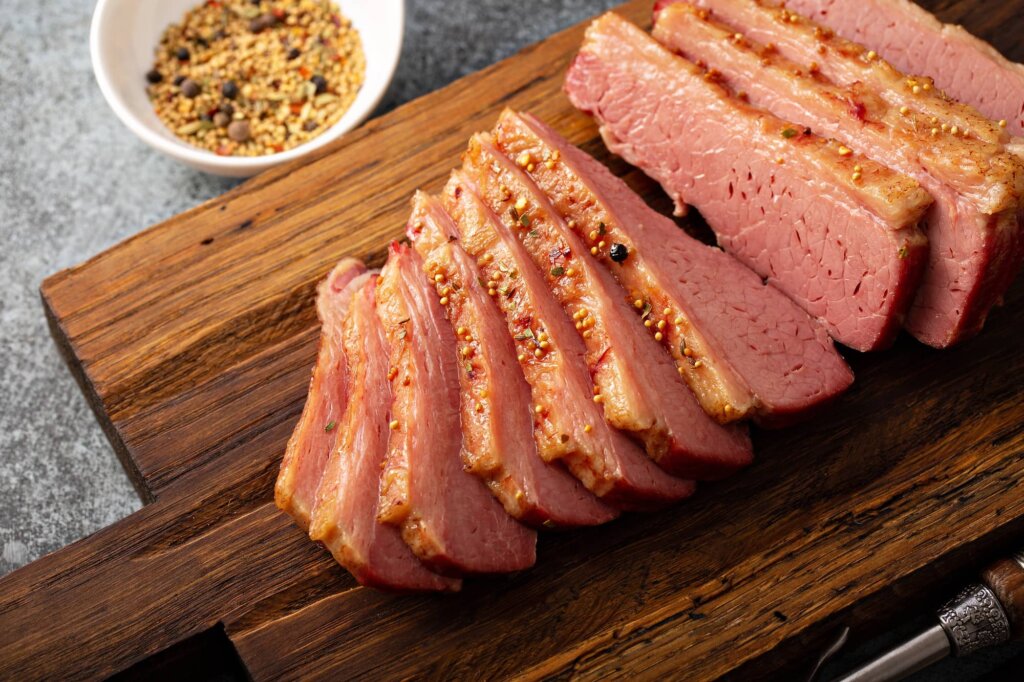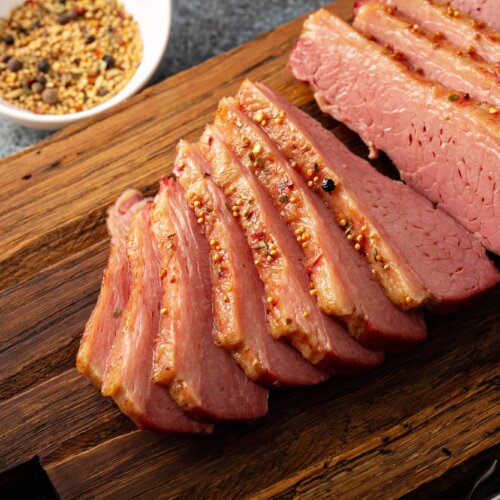
For some, corned beef is a breakfast treat that must be paired with fried eggs and potatoes. Others associate this richly flavored beef dish with St. Patrick’s Day and Irish heritage in general. No matter when you want to enjoy it, corned beef takes some time and planning to prepare at home. Getting started with a brisket already in the curing brine saves a lot of time and eliminates potential risks that come with home brining. No matter how your corned beef is prepared, you can use your favorite crockpot to get a perfect texture with a hands-off cooking process.
What is Corned Beef and What Cut Should I Buy?
Corned beef is a large cut of beef roast, usually the flat end of a brisket, that is brined before cooking. The process of brining with salt and specific spices is known as corning and has a long history as a method for preserving meat. While corning is used more for adding flavor and softening texture than preservation today, it remains popular in many European cuisines. Joining in on the corned beef experience is easier than you might think in the home kitchen, especially if you choose a piece of meat that has already been brined.
If you’re starting from scratch and don’t want a pre-packaged corned beef roast, look for a half brisket. The whole brisket is a little too large to cook in the home kitchen, but the flat cut in particular is a good size and has the right texture. If you prefer more fat and marbling in your corned beef, use the point cut. The slow cooker method ensures that even the less even shape of the point cut is properly cooked without burning or overcooking. Other cuts of beef that take well to corning include skirt, chuck, and flank roasts.
Common Mistakes Made When Cooking Corned Beef
- Using a high heat setting on the slow cooker: Corned beef needs a slow and low-temperature cooking method to soften up. Use the medium heat setting at the most on your slow cooker to prevent a tough end result.
- Letting the liquid level drop: No matter the cooking liquid, it needs to cover the entire roast during the majority of the cooking process. Letting the liquid level drop during cooking will dry out the corned beef and reduce its flavor.
- Slice the finished meat against the grain: Slicing along the grain will lead to chewy results even with the best corned beef. Always slice against the grain with a sharp knife for thin and neat slices.
How to Prep the Crock Pot
There is no special prep needed to get the crockpot ready for this kind of cooking process. Since you’ll use plenty of liquid the whole time, there shouldn’t be too many sticky deposits left on the sides of the slow cooker. You can use a liner if you prefer, but make sure it’s rated for use with higher heat levels.
How to Prep the Corned Beef
Some older forms of corned beef were preserved with so much salt that they needed soaking for hours before cooking. The majority of brined roasts you’ll find sold in the stores don’t need that kind of preparation. Just rinse the meat off before putting it in the crockpot to control how much salt is added to the cooking water. The seasoning packet will contain everything you need to add to the cooking liquid, or you can use your own mix of seasonings as listed in the recipe below. There’s no need to let the meat reach room temperature or trim the fat off since it cooks in liquid for so long.
Recipe Variations
One trick for a new twist on the same old corned beef is to take the roast out of the braising liquid when it is nearly soft enough to push a fork through. Rub the exterior with a mix of Dijon mustard and brown sugar, then roast it in the oven for 20 minutes at 400 degrees F. If you want a sweet and savory mix in the crockpot alone, try swapping some of the usual braising liquid out for 2 tablespoons of real maple syrup and 3 tablespoons of brown mustard.
How to Serve Corned Beef
Many people prefer corned beef sandwiches, which are generally made with the sliced meat after it cools down from cooking. You may want to braise potatoes, carrots, and cabbage along with the meat and serve it all together as a classic Irish boiled dinner. Pairing slices of warm corned beef with roasted vegetables and mashed potatoes is another popular option. Don’t forget that this kind of corned beef makes great hash for breakfast. Chop the meat into small cubes along with raw potatoes and fry it all in a little oil or lard for a taste explosion. Of course, leftover corned beef makes great Reuben sandwiches. Don’t skimp on the sauerkraut when putting together a sandwich with your own homemade corned beef brisket.
Crock Pot Corned Beef Recipe
Start with a brined corned beef roast from a store since brining the meat yourself requires Prague salt and other specialty ingredients to ensure food safety. You can always put your own twist on the meal by using your own spices rather than the spice packet.
Ingredients
- 1 brined corned beef brisket, around 5 to 6 lbs
- 3 tablespoons of the pickling spice included with the meat, OR the following:
- 1 tablespoon of whole mustard seeds
- 1 teaspoon of black peppercorns, whole
- ½ teaspoon of whole anise seeds
- 6 whole cloves
- 3 cardamom pods
- 5 large bay leaves, crushed
- ½ teaspoon of allspice
- 1 teaspoon crushed red pepper flakes
- 1 can of low sodium beef broth
- 3 garlic cloves, peeled and sliced
- 3 cups of water
- 1 lb each of red potatoes, cabbage wedges, carrots, and celery
Instructions
1. Use a large crockpot that can accommodate the roast plus all the vegetables you want to add. Consider cooking the vegetables separately if there isn’t enough room to fill the slow cooker with the liquid.
2. Rinse the corned beef and place it in the crock pot. Surround it with vegetables. Add the spice packet or the spices listed. Pour in the beef broth and as much of the three cups of water as you need to cover the meat entirely.
3. Set the slow cooker on medium heat. Begin checking the corned beef for doneness around 5 to 6 hours after you start cooking. Aim for a texture where a fork easily pierces the meat to the center, but it’s not falling apart at the slightest pressure yet. Keep cooking if the corned beef still seems too firm.
Notes
Getting the perfect texture takes a little practice. Avoid cooking to the exact softness you want since the meat will continue heating briefly after you stop cooking it. You may find that a perfect tender roast turns to shreds by the time it’s done resting, so stop a little short of the desired texture.
Crock Pot Corned Beef – Nutritional Facts
Per Serving (6 oz Corned Beef + 1 Cup Cooked Vegetables, Based on a 2,000-Calorie Daily Diet)
| Nutrient | Amount (% DV) |
|---|---|
| Calories | 480 |
| Total Fat | 30g (38%) |
| Saturated Fat | 11g (55%) |
| Cholesterol | 110mg (37%) |
| Sodium | 1,200mg (52%) |
| Total Carbohydrate | 17g (6%) |
| Dietary Fiber | 3g (11%) |
| Sugars | 4g |
| Protein | 36g (72%) |
| Iron | 3.6mg (20%) |
| Vitamin C | 18mg (20%) |
| Calcium | 52mg (4%) |
| Potassium | 610mg (13%) |
Conclusion
Corned beef is unique in both flavor and texture. It deserves to be enjoyed more than once or twice a year and takes little effort to whip up with the help of a slow cooker. Make corned beef a part of your regular meal rotation with this method.

Crock Pot Corned Beef
Ingredients
- 1 `5-6lbs brined corned beef brisket
- 1 can low sodium beef broth
- 3 cloves garlic, peeled and sliced
- 3 cups water
- 1 lb of each red potatoes, cabbage wedges, carrots, celery
- 3 tbsp pickling spice included with the meat
Or, combine the following seasonings together:
- 1 tbsp whole mustard seeds
- 1 tsp black peppercorns, whole
- 1/2 tsp whole anise seeds
- 6 whole cloves
- 3 cardamom pods
- 5 large bay leaves, crushed
- 1/2 tsp allspice
- 1 tsp crushed red pepper flakes
Instructions
- Use a large crockpot that can accommodate the roast plus all the vegetables you want to add. Consider cooking the vegetables separately if there isn’t enough room to fill the slow cooker with the liquid.
- Rinse the corned beef and place it in the crock pot. Surround it with vegetables. Add the spice packet or the spices listed. Pour in the beef broth and as much of the three cups of water as you need to cover the meat entirely.
- Set the slow cooker on medium heat. Begin checking the corned beef for doneness around 5 to 6 hours after you start cooking. Aim for a texture where a fork easily pierces the meat to the center, but it’s not falling apart at the slightest pressure yet. Keep cooking if the corned beef still seems too firm.

